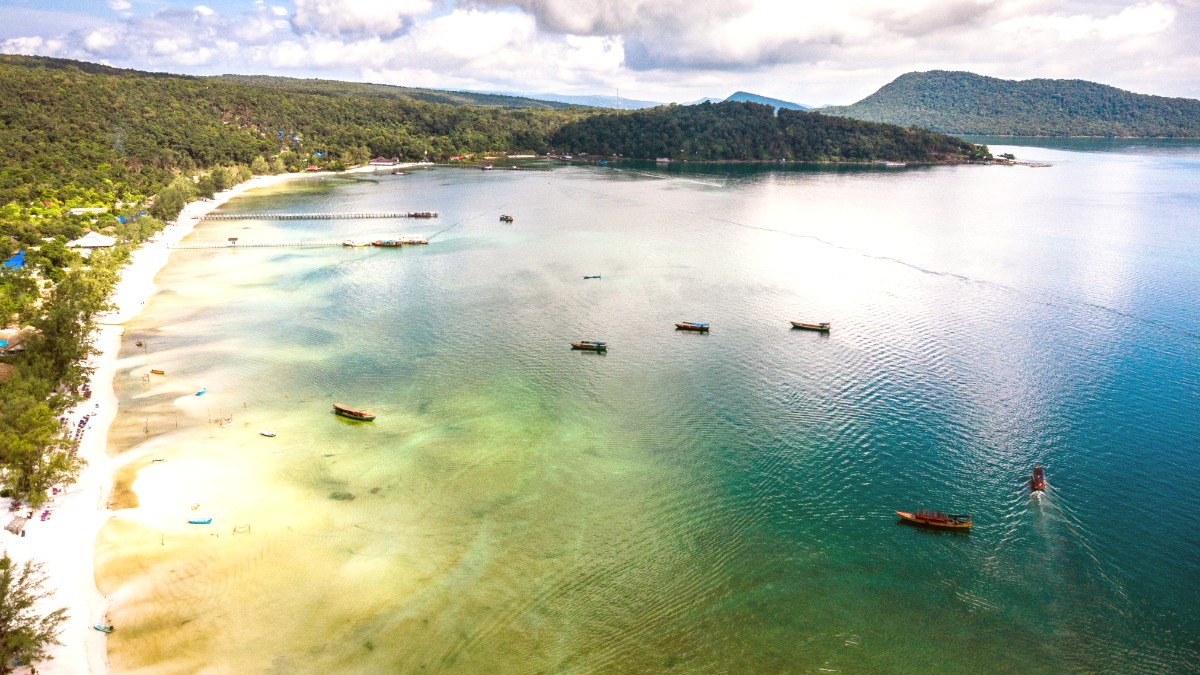
Cambodia
Koh Rong experiences a tropical monsoon climate. This means high temperatures and humidity throughout the year, with distinct periods of heavy rainfall.
Dry Season (November to May): This period brings the most pleasant weather for beach activities. From November to February, temperatures usually range from 25°C to 30°C (77°F to 86°F). This is the coolest and least humid part of the dry season. Skies are typically clear, and seas are calm. Mornings feel crisp, and daytime sun is abundant. Evenings offer a comfortable coolness, perfect for outdoor dining. This period is popular for good reason; conditions stand ideal for exploring all parts of the island.
March to May: Temperatures rise notably during this period, often reaching 30°C to 35°C (86°F to 95°F). Humidity also increases, especially as May approaches. Rainfall stays minimal, but the intense heat makes midday activities uncomfortable. The sun feels strong, calling for diligent use of Sun protection and hydration. The ocean offers a refreshing escape from the heat, and calm seas persist, making water sports enjoyable.
During the wet season (June-October), tropical storms bring heavy rain, flash flooding, and strong winds. These conditions cause ferry cancellations, disrupt travel, and affect island activities.
The period from March to May experiences very high temperatures. This renders midday sun exposure uncomfortable and leads to heat exhaustion if travelers do not take precautions. Plan outdoor activities for early mornings or late afternoons during these months. Stay hydrated throughout the day.
Mid-November to February
Weather at its best: clear skies, abundant sunshine, lower humidity, calm seas. Ideal conditions for water activities and island hopping. All businesses operate fully.
Higher prices for accommodation, flights, and ferry tickets. Beaches and popular areas, especially Koh Touch, become crowded. Booking well in advance becomes a requirement.
March to May, early November
Fewer crowds than high season. Prices for accommodation and transport begin to decline. Good weather generally persists, though March to May can be very hot.
Humidity increases significantly in late shoulder season (April-May), making it feel hotter. There is a chance of early monsoon rains in November. Some smaller businesses might close for renovations in May.
June to October
Lowest prices for accommodation and activities. The island feels tranquil, with many beaches almost deserted. Waterfalls flow freely, offering lush scenery.
Frequent, heavy rain showers. Seas can become rough, leading to potential ferry cancellations or delays. Visibility for snorkeling and diving decreases. Some businesses might close for the season.
Beach relaxation, snorkeling, diving, and island hopping: The dry season (November to May) features the best conditions. Calm seas lead to optimal visibility for underwater exploration. Sunny days make beach relaxation enjoyable.
Jungle trekking: The dry season stands preferable for clearer paths, fewer leeches, and comfortable hiking conditions. However, the wet season offers lush scenery and active, flowing waterfalls, which a trekker ready for muddy conditions finds rewarding. Bioluminescent plankton viewing: This natural spectacle is best viewed during the dry season on moonless nights. Clear skies and calm waters boost visibility. Light pollution on Koh Touch can reduce visibility; seek out darker bays for a better show.
November - February (Dry Season)
March - May (Dry Season)
June - October (Wet Season)
Shoulder & Low Season
Dry Season, dark nights
Cambodia welcomes most foreign nationals with a valid visa for entry. The process presents flexibility, with options for both pre-arrival applications and on-arrival visas. Proper preparation streamlines your entry into the country.
Cambodia provides several visa options for tourists:
The E-Visa streamlines your entry:
Choose Cambodian dishes over Western food; local meals are flavorful and cheaper. Look for eateries serving Khmer specialties. Many bars and restaurants offer happy hour deals on drinks and sometimes food, a way to save on evening expenses.
Buy large 5-liter bottles of water from local shops and refill your smaller reusable bottle; this significantly cuts costs and plastic waste. A Sawyer Products Squeeze Water Filter System offers long-term savings and environmental benefits, supporting safe tap water purification. For nearby beaches, walking trails often connect them. This saves on boat taxi fares and offers island exploration by foot. Confirm path safety and accessibility before setting out.
For boat taxis or small purchases, polite negotiation yields a slightly better price.
Avoid ATM fees by withdrawing a larger sum in Sihanoukville or Phnom Penh. Secure cash in a Money belt or Secure travel wallet.
Visiting during shoulder or low season brings lower prices and fewer crowds.
Budget: $25-45; Mid-Range: $70-150; Luxury: $250-800+.
Sihanoukville-Koh Rong Speed Ferry (one-way): $12-15.
While Cambodia generally offers a safe environment for tourists, awareness of common health concerns, crime risks, and local emergency procedures stands prudent. Proper preparation allows focus on enjoying the island's beauty.
No vaccinations hold mandatory status for entry into Cambodia for general travelers. Consult a travel health professional 4-6 weeks before your trip for advice based on your personal health history, itinerary, and duration of stay. Ensure your routine vaccinations are current.
Good practices for health and safety:
Awareness and prevention for common traveler ailments: